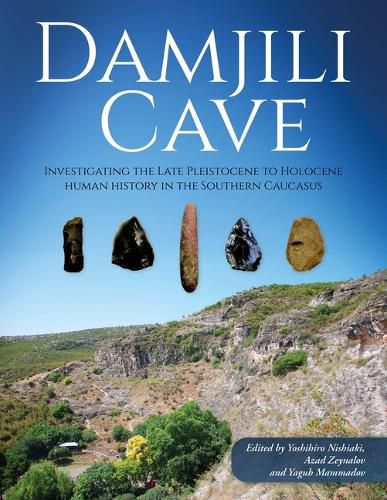Readings Newsletter
Become a Readings Member to make your shopping experience even easier.
Sign in or sign up for free!
You’re not far away from qualifying for FREE standard shipping within Australia
You’ve qualified for FREE standard shipping within Australia
The cart is loading…






Presents archaeological evidence from the Azerbaijan-Japan excavations, revealing insights into Mesolithic to Neolithic transition and farming communities in the South Caucasus.
Modern archaeological research carried out since the late 19th century has sufficiently demonstrated that the beginning of the food production economy and the establishment of a farming society had a significant impact on the shaping of subsequent human history. Accordingly, these processes of Neolithization have attracted a great deal of interest from archaeologists and anthropologists worldwide. The South Caucasus, i.e. the region discussed in this book, has remained one of the least studied regions in a modern sense. However, the research situation has improved remarkably since the 2000s, for a number of reasons, above all the increasing efforts of local and international archaeologists in collaboration.
Since 2008, the Azerbaijan-Japan Archaeological Mission has played a major role in elucidating the origins and developments of the earliest farming communities in the South Caucasus, conducting a series of field campaigns in West Azerbaijan. The remarkable achievements made thus far include the establishment of a secure chronological framework for understanding the Neolithization processes in the early 6th millennium BC through the excavations of two important Neolithic sites: Goeytepe and Haci Elamxanli Tepe in the Tovuz region, representing the early and late phases of the Neolithic of the South Caucasus, respectively, dating from the early 6th millennium BC.
This volume presents a set of archaeological evidence obtained from the Azerbaijan-Japan excavations in 2016-2022 at Damjili Cave, West Azerbaijan. The cave contained cultural layers from the Mesolithic period in particular, along with Neolithic, Chalcolithic, Bronze Age and medieval material indicating a very long sequence of use. Earlier explorers recorded Middle Palaeolithic lithic artifacts, though no tools of this period were recovered during the recent program of work. Ten small trenches were excavated, revealing a considerable depth of deposits. Mesolithic lithic materials provided evidence for obsidian blade production. Neolithic levels, that included some amorphous limestone block structures, hearths and pits, produced flaked and ground stone tools, pottery and bone objects. Part of the cave at least was utilized in the medieval period with evidence for some built structures and several burials. A program of environmental sampling and both radiocarbon and luminescence dating were undertaken. Through combining the records of the late (Goeytepe), early Neolithic (Haci Elamxanli Tepe), and Mesolithic (Damjili Cave) periods, our understanding of the Neolithization processes of the South Caucasus will be greatly improved. Data from a combination of three chronologically different sites provide the first opportunity to observe Neolithization processes with secure stratigraphic evidence in a small region of West Azerbaijan.
$9.00 standard shipping within Australia
FREE standard shipping within Australia for orders over $100.00
Express & International shipping calculated at checkout
Presents archaeological evidence from the Azerbaijan-Japan excavations, revealing insights into Mesolithic to Neolithic transition and farming communities in the South Caucasus.
Modern archaeological research carried out since the late 19th century has sufficiently demonstrated that the beginning of the food production economy and the establishment of a farming society had a significant impact on the shaping of subsequent human history. Accordingly, these processes of Neolithization have attracted a great deal of interest from archaeologists and anthropologists worldwide. The South Caucasus, i.e. the region discussed in this book, has remained one of the least studied regions in a modern sense. However, the research situation has improved remarkably since the 2000s, for a number of reasons, above all the increasing efforts of local and international archaeologists in collaboration.
Since 2008, the Azerbaijan-Japan Archaeological Mission has played a major role in elucidating the origins and developments of the earliest farming communities in the South Caucasus, conducting a series of field campaigns in West Azerbaijan. The remarkable achievements made thus far include the establishment of a secure chronological framework for understanding the Neolithization processes in the early 6th millennium BC through the excavations of two important Neolithic sites: Goeytepe and Haci Elamxanli Tepe in the Tovuz region, representing the early and late phases of the Neolithic of the South Caucasus, respectively, dating from the early 6th millennium BC.
This volume presents a set of archaeological evidence obtained from the Azerbaijan-Japan excavations in 2016-2022 at Damjili Cave, West Azerbaijan. The cave contained cultural layers from the Mesolithic period in particular, along with Neolithic, Chalcolithic, Bronze Age and medieval material indicating a very long sequence of use. Earlier explorers recorded Middle Palaeolithic lithic artifacts, though no tools of this period were recovered during the recent program of work. Ten small trenches were excavated, revealing a considerable depth of deposits. Mesolithic lithic materials provided evidence for obsidian blade production. Neolithic levels, that included some amorphous limestone block structures, hearths and pits, produced flaked and ground stone tools, pottery and bone objects. Part of the cave at least was utilized in the medieval period with evidence for some built structures and several burials. A program of environmental sampling and both radiocarbon and luminescence dating were undertaken. Through combining the records of the late (Goeytepe), early Neolithic (Haci Elamxanli Tepe), and Mesolithic (Damjili Cave) periods, our understanding of the Neolithization processes of the South Caucasus will be greatly improved. Data from a combination of three chronologically different sites provide the first opportunity to observe Neolithization processes with secure stratigraphic evidence in a small region of West Azerbaijan.